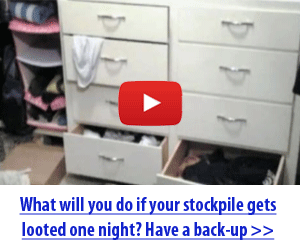Thinking about building a bunker shelter? Apocalypses are rare events fortunately, however, there is…
Nothing Wrong With Being Prepared!
Natural disasters can strike with only a little notice and do a lot of harm. We’ve certain had our share of floods and hurricanes lately!
In response, millionaires have arranged for deep underground shelters for themselves and their loved ones that allow them live off the grid for up to five years, never even seeing the surface. Whether they are necessary is irrelevant—the question is will they be useful?
It is the logistics that are off…they put them in distant places where they’d have to travel a long time to get there. That’s great if you have weeks of warning. It’s less useful if your bunker is in the middle of Kansas, but you live in Miami during a missile attack. Being impractically placed means that some of these super shelters may go completely unused by being too far out of the way.
Threats to Think About
Nukes
Ninety percent of the world’s nuclear inventory is held by the United States and by Russia, countries that had the most sophisticated command structure to keep nukes sage. The rest 10% of the world’s nuclear arsenal is held by Britain, China, France, India, Israel, North Korea, and Pakistan. The only worry-free ones seem to be Britain and France…
There aren’t a lot of pressures right now to actually use nukes—thank Common Sense—but there is a lot of posturing suggesting: “We have it, and we could use it, if we wanted to” going on…
Nature
Large asteroids or comets, deciding to make Earth their new home, could make our environment just as bad as any nuclear exchange would. They’d throw as much dust up into the atmosphere as the bombs, and we’d be months or years without sunlight, so all the plants, animals, and most of the people would die because there would be no food. Yes, a rare event, but it deserves some thought.
On a more ordinary note there are the possibilities of hurricanes, earthquakes, tornados, floods, and other natural disasters or emergencies. Those could make life difficult if you happen to be in their path.
Government
When it works, there’s nothing for us to worry about. It has been decades since there was a world wide war, and it is very unlikely that anyone of us will get bombed soon. Is there any need to worry about impending collapse of economic order? Who knows. However, as long as you’re not hurting anyone, what you do on your own property is your own business, right?
Build a Bunker
Believe it or not, we’ve been doing it in this country since the 1960s.
Back then it was not uncommon for people to build bomb shelters beneath their homes. Blueprints were widely distributed in everyday magazines such as TIME, LIFE, Popular Science, and many more.
Often they were shown as just a duplicate of your home’s living room “above”, but with a reinforced 20” concrete ceiling and 12” thick walls and a massive supply of preserved food to make your family self-sufficient. Sleeping arrangements were foldable cots to save room, and entertainment was a hand cranked record-player!
We have better “modular” designs nowadays, and companies that are dedicated to serving the needs of preppers, but you can still do it on your own, if you desire. Bunkers can be quite costly to purchase, and then to install, but you can also make them into an extension of your home and use the space rather than letting it sit idle.
Someone to do it for us
Popular companies, like ATLAS, RISING S, or Survive-a-Storm Shelters now provide prebuilt, bolt and weld together components. It can be a basic tube, a bigger, more complete box-style, a large dome, or a buried Quonset hut design. The sizes vary from small surface Tornado Shelters all the way up to 6,000 square feet (560 m2) of subterranean villa that could hold a whole neighborhood.
Some commercial groups are refashioning decommissioned missile silos into emergency shelter space. One luxury version was designed with nine floors of residences, and several floors of services such as power, sewage, and water supply. You even have shopping carts to go “grocery shopping” (from the three-to-five year food supply of freeze dried and dehydrated foods), lounges, theaters, fake seashore swimming pool, rock-climbing walls, and similar amenities. The buy-in was between $1.3-4.5 million, depending on number of bedrooms needed and it can sustain about 75 people.
The Survive-a-Storm people even provide a call service that contacts you when an event affects your area in case debris falls on your exit and you cannot get out on your own. If they can’t contact you, they inform emergency services to come and rescue you.
You can get pretty much anything you want, if you have the cash, including a 40 person shelter complete with multi-car garage, workshop, and a massive LED-powered greenhouse, all safely underground.
Doing it yourself
Concrete bunkers made with self-healing concrete are pretty resilient and can last more than 100 years with next to no maintenance. They also give you a lot of design options not available in a pre-built unit. Echoes are eliminated once you have furniture and other sound absorbing materials inside, plus concrete provides a strong base to mount fixtures.
Having a separate room for (fueled) power generation with a stainless steel exhaust to the surface keeps carbon monoxide out of your living space. You also need an NBC (Nuclear Biological Chemical) filter system for replacing air on a regular basis. Air circulation can be a powered system, when you have electricity, that runs automatically, or a manual system that you hand crank three or four times per day.
In a separate closed room, with positive pressure exhaust to the outside, you can have a composting toilet to make fertilizer, if you have a garden. The exhaust keeps the smell down. Otherwise, you’ll need a chemical toilet, or if you have a well, a powered up-flush toilet to remove waste to a tile field well-away from your water supply. Consider a bidet-toilet arrangement, too. Toilet paper may be safe in composting systems, but storing enough for a year could needlessly use up a lot of space…
Alternatives
Shipping containers seem ideal and are readily available, but they should be used with a great deal of caution. They are engineered to support a lot of weight on their floors, and the corners are designed to transfer huge weights vertically so they can be stacked. The roofs and walls, however, are not designed for the pressure of soil or concrete on the outside surfaces.
These things collapse easily if not properly reinforced. It’s really worth it to have an engineer look over your plan before you even buy the container, to tell you if it is possible. And then it’s a good idea to buy a one-trip container that hasn’t been beaten and abused on many crossings. It’s cheaper than new, but more costly than an old one with lots of vulnerable dents and dings.
Inspect them in person before committing to buy them. They can’t be misshapen or they won’t sit properly on your concrete pad. Containers must be free of fumigants, pesticides, algaecides, and all the other protective treatments placed on their wooden interiors or you’re going to be breathing that stuff. This often means removing the existing wood, sandblasting the interior, repainting it with marine grade epoxy paint, and then installing new wood with no toxic chemicals that can leak VOCs (Volatile Organic Chemicals).
The same goes for the outside—epoxy paint everywhere. Your engineer will probably recommend no less than 2-inch (50 mm)steel square-tube all the way around the outside, 1/3 of the way from the roof, and 1/3 of the way from the floor, welded completely, just for basic support against the soil or concrete pressure.
If you don’t take some precautionary measures, no matter what you’ve heard to the contrary, you shelter is in danger. Not only do you risk collapse while inside, but left unattended, distortions can cause leaks and flooding that can destroy your emergency food supply, survival equipment, and the clean, safe water that you have put aside for that dreaded WSHTF day.
The roof will also need an 8” x 12” wooden beam, on the inside, the full length of the roof. This will support the concrete/soil on top used to hide the container. The beam will require support along its length by square-tube framing that goes all the way from ceiling to floor. Since this will use some headroom, it’s better to get a taller container than a short one.
Don’t need a shelter?
Let’s say you’ve got a serviceable shelter, but you’re lacking long term storage space. Consider a septic tank! Even if someone notices it, they’re sure not going to open it… They know what is supposed to be in there and they’re not interested…
These things are often solid polyethylene, or other durable plastic, and are relatively inexpensive. One 1,250 gallon (4.7 m2) tank is about $1,200, and that is a lot of tough, durable storage space. They come standard with a manhole cover-sized opening, so you can fit inside easily enough.
They’re specifically designed to be buried and stand up against all the usual underground problems. After a week or month in your shelter, most short term dangers are past, so you can pop out, restock from this buried cache, decontaminate yourself if necessary, and get back inside. Fresh supplies—Whoo-hoo! It’s like having a store in your backyard.
The Takeaway
Lots of DIY shelters have failed due to roof or wall collapse, flooding, or rusting due to poor prep work. Imagine putting an eight foot (2.4 meters) tall container, six feet (1.8 m) below the surface when the water table is only 12 feet (3.7 m) down… You’re likely going to arrive and find it knee-deep in water because no one checked before building anything and then didn’t waterproof properly!
There are companies that make waterproof shelters, completely welded steel joints on every exterior surface, then it’s primed, rust-proofed, and then triple-coated in epoxies, and perfectly safe. You really can’t tell where the water is on your own so consult a professional. Digging a well will reveal where the water lies and it can supply your bunker’s needs. Two birds…one stone…
So don’t just jump in and start digging. Remember…it all starts with a good foundation, both literally and figuratively. Do some investigating and talk to real experts because there is a lot of really bad information on the internet that says: “Oh, just go ahead and do it. It’ll work out fine!”
The truth is that it’s harder than that. If the frame bends, you probably won’t even be able to open the door… You really need to make sure you are not going to arrive at your emergency shelter when you really need it, actually get the door open, and only then find it useless and full of muddy water. Talk to an engineering professional and do the job right…because, you know…zombies…


